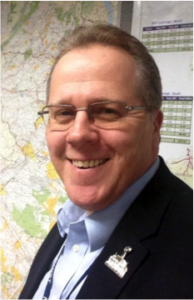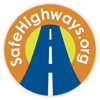Headlights on… Sal Cowan
Current Agency: New Jersey Department of Transportation (NJDOT)
Department: Transportation Systems Management
Position/Title: Director of Traffic Operations
Please describe your early aspirations, experiences, and career goals that led to your current role with the NJDOT.
I always enjoyed working with people. I started college as a political science major. I interned at a NYC radio station in college and fell in love with being involved in day to day operations of something so dynamic and constantly changing.
How has your professional background prepared you for your position as Director of Traffic Operations?
Working at Metro Traffic was an amazing experience. I learned so much about how government agencies communicate and that public servants want to help people. As the media, we wanted to get information to drivers for them to make informed decisions. I also got to fly in a helicopter, which was incredible. Talk about a different perspective on alternate routes!
For over a decade, you worked in the private sector with a mixture of experience in broadcast, advertising analytics, and emergency incident planning before joining the NJDOT in 2011. What is the greatest distinction between working for the public and private sectors? What are some of the common misperceptions each sector has about the other?
Every workplace has similarities and differences, but they all have rules to follow. Some people think it’s harder in the private sector than in the public sector. I’ve worked in both. You’ve got great people on both sides of the fence…some people just think the grass is greener on the other side. It’s not…it’s just different grass.
Congratulations on receiving the 2015 Transportation Advancement Award for your work on successfully preparing and implementing traffic operations plans for several major events and construction projects, including Super Bowl XLVII and the Papal Visit to New York and Philadelphia! What were the key elements that account for your success preparing for and mitigating the congestion and its consequences?
Thank you. It was a great honor to work on such an amazing event. Preparation and partnership were key to getting it done. We tried to look at every possible aspect of “what can we do.” Our unit regularly drafts operations plans for events but the scale of the Papal visit was tremendous. I walked into a room of DOT executives asking for support from their unit (should I need it) to act as a liaison for the Papal event. Before I got back to my desk, I had commitments from every unit in NJDOT asking how they could help make this a success. That’s teamwork!
What suggestions do you have for other directors of traffic operations when preparing for similar events?
First, make sure the right players are involved. We were in meetings with everyone from the SSP Supervisors to the Secret Service. Everyone has their role, but they’re all willing to help determine the best approach to including them in your plan. Second, look to engage other agencies that have participated in similar events. FHWA is a great resource for supporting peer to peer exchanges on major events like this. Lastly, plans are great until the first thing happens and you need to improvise. Keep additional resources on hand. You never know who’ll ask you to find and deploy a dozen pieces of remote ITS equipment two days before the event!
What similarities and differences exist in the procedures taken for preparing for scheduled events, like the Super Bowl, versus natural disasters, such as Hurricane Sandy in 2012?
You can conceive, develop, and create plans to mitigate any traffic related event. The difference is that with most special events, you have lanes open to full capacity. Disasters can quickly eliminate capacity and you have to quickly determine what remains of the transportation network to support your plan. One thing is certain, you need strong partners within your organization and with others in Incident/Emergency Management to help make appropriate changes to what can be done in an emergency.
Does the role and responsibility of Safety Service Patrol (SSP) change for scheduled and unscheduled events?
SSP’s role is to always provide safety and support to the motoring public and first responders. So whether they’re dispatched for a scheduled event like the 2016 Papal visit or a major storm, they always work to ensure whoever is on NJ’s road network (whether as part of their job or just by unfortunate circumstances) is safe.
In your opinion, what are the most important qualities and skills a member of the SSP team should possess?
NJ’s Safety Service Patrol employees are, without a doubt, the hardest working employees that I’ve ever worked with. Their determination to get lanes open as safely and expeditiously as possible are qualities that help make NJ’s roads safer for everyone. As far as skills, we’ve got employees from all walks of life. From former tow truck company owners, to former DOT maintenance personnel to firefighters and law enforcement. Everyone brings something unique to the job.
How do you measure and track performance of the SSP? Which metric(s) carry the most weight in your evaluation?
We track a lot of data for our program. From miles driven to types of service provided per stop to average time drivers spend per stop. I’d say the metric that carries the most weight is the feedback we receive from our Customer Service Comment Cards. That gives us a true understanding of how NJ’s program is truly helping people. We’ve helped people injured in accidents, broken down school buses full of kids, celebrities with a flat tire, and folks in our own government with mechanical problems. Hearing how we’ve helped all of them reminds me how important the program is to people.
What resources do you use to facilitate the safe and effective operations of the SSP program?
Our vehicles are equipped with the tools our staff needs to safely support incidents along our roadways. Lockout kits, cones, flares, speedy-dry, brooms, shovels, portable emergency signs, aluminum jacks…the basics for cleaning up an incident. I think the most valuable resource is the dynamic message board we have on every truck. Operators can display the SLOW DOWN, MOVE OVER message when they’re on the side of the road to remind drivers to follow NJ’s Move Over Law and help protect first responders.
What changes and improvements have been made to the SSP over the years to ensure safety remains the top priority?
Our vehicles have undergone changes. When the program started, we used vans. We currently use utility trucks with a sturdy steel frame, a roll cover across the truck bed, and significant emergency lighting. We’ve just finished designing our new vehicle fleet with additional storage, new boards, backup cameras, and other features.
How do you envision the SSP program will change over the next decade?
I believe that technology will give us new and more accurate tools to quickly detect and respond to incidents. In line with that, NJDOT is working on integrating various data-sets so that information can be sent more efficiently from our SSP vehicles to our Traffic Operations Centers.
What would you like other states to know about the NJDOT SSP?
NJ’s SSP staff are all trained in Traffic Incident Management. FHWA’s TIM program staff have done an excellent job in promoting safety of responders and mobility of the public in the program and we feel it’s valuable for any staff that puts their foot on the pavement. Some of our SSP staff are also nationally trained TIM instructors so they practice what they preach.
What would you like to know about other state’s Safety Service Patrols?
Anything and everything about other state programs! From equipment to gear, technology to best practices. Our programs can learn from each other and create a safer transportation network if we share our ideas.
Back to Safe Highway Matters Fall 2016
